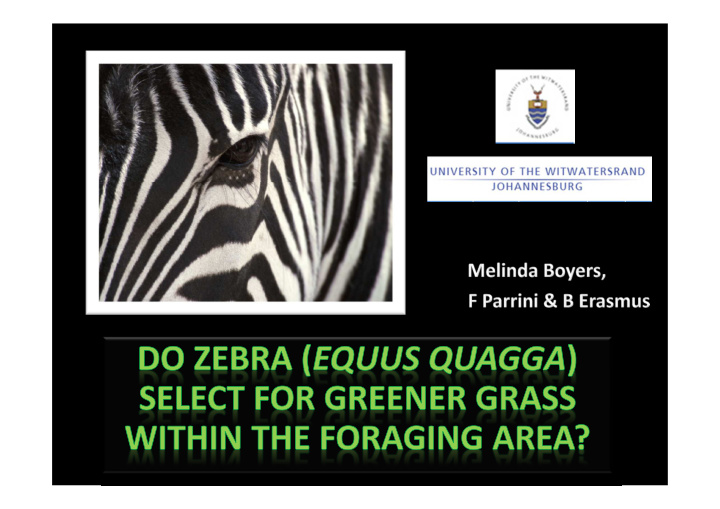



Motivation for study • Large herbivore grazing Landscape distribution patterns Foraging are hierarchical in nature area – varying organisation Feeding levels of forage selection patch • Finer-scale studies are Feeding needed station – Herbivore response to Bite greenness Senft et al. 1987 & Bailey et al. 1996
Objectives • Objective 1: – To determine whether zebra select for the greener grass tufts within feeding stations • Objective 2: – To determine whether zebra select for the greener feeding stations within a foraging area
RESTING Feeding Patch EATING DRINKING FORAGING AREA EATING RESTING
FEEDING PATCH
Study area Manyeleti Game Reserve
GRASS TUFT SELECTION
Objectives & Hypotheses • Objective 1: – To determine whether zebra select for the greener grass tufts within feeding stations • Hypothesis – Zebra are selective and select for greener tufts of grass. – Zebra select for certain species – Zebra select for the greener species
Data Analysis • Binary response variable – Grazed / non-grazed • Explanatory variables – Greenness categories according to Walker scale – Individual species • Themeda triandra • Panicum maximum • Digiteria eriantha • Urochloa mosambicensis • ‘Other’ • Change over Season • Mid dry (Aug – Sep 2010) • Late dry (October 2010) • Early wet (November 2010)
Model Selection • Logistic regression • Response variable – Grazed/Non-grazed • Best model (AICc) – Species X Greenness & Species X Season – Estimated coefficients – Log-odd ratios
Greenness
Species
Interaction: Species vs Greenness
Interaction: Species per Season
FEEDING STATION SELECTION
Objectives & Hypotheses • Objective 2: – To determine whether the zebra select for the greener feeding stations within the foraging area • Hypothesis – Within a foraging area, zebra select feeding stations that are greener – The presence of certain grass species increases the selection of a feeding station – The presence of certain grass species together with the greenness of the feeding station during a specific season increase selection of a feeding station
Data Analysis • Binary response variable – Grazed / non-grazed • Explanatory variables – NDVI values ‘Greenness’ – Absence/presence of Individual grass species – Change over Season
Feeding station Greenness Mid dry Late dry 100 100 100 100 90 90 90 90 Availability of feeding stations (%) Availability of feeding stations (%) 80 80 80 80 Availability grazed (%) Availability grazed (%) 70 70 70 70 60 60 60 60 50 50 50 50 40 40 40 40 30 30 30 30 20 20 20 20 10 10 10 10 0 0 0 0 < 0.2 0.3 - 0.4 - 0.5 - > 0.6 < 0.2 0.3 - 0.390.4 - 0.49 0.5 - > 0.6 0.39 0.49 0.59 0.59 NDVI Values NDVI Values
Model Selection • Logistic regression • Response variable: – Grazed/Non-grazed • Best model: – NDVI X Individual Species & Season X Individual Species – Estimated coefficients – Log-odd ratios
Interaction: Greenness vs Species
Key points • Zebra selection was not consistent across scales • Grass tuft selection was based on: – A combination of both species and greenness – Will eat less palatable species if the greenness is higher • Feeding station selection is based on: – NOT Species – Greenness
Conclusion • At grass tuft level Landscape – Zebra select towards greenness However.... Foraging area • Feeding station: Feeding patch – No strong pattern Feeding – Man-made organisation level station – Grass tuft level ?? Bite – Landscape level?? • Further studies are needed at the larger scales to be able to compared
Thank you Acknowledgments: • Supervisors: • Dr F Parrini • Dr B Erasmus • Manyeleti Game Reserve • National Research Foundation
Grass Tuft Greenness Available % Grazed % 100 100 90 90 Available grass tufts (%) 80 80 Grass tufts grazed (%) 70 70 60 60 50 50 40 40 30 30 20 20 10 10 0 0 1-10 11-25 26-50 51-90 Greenness (%)
Recommend
More recommend